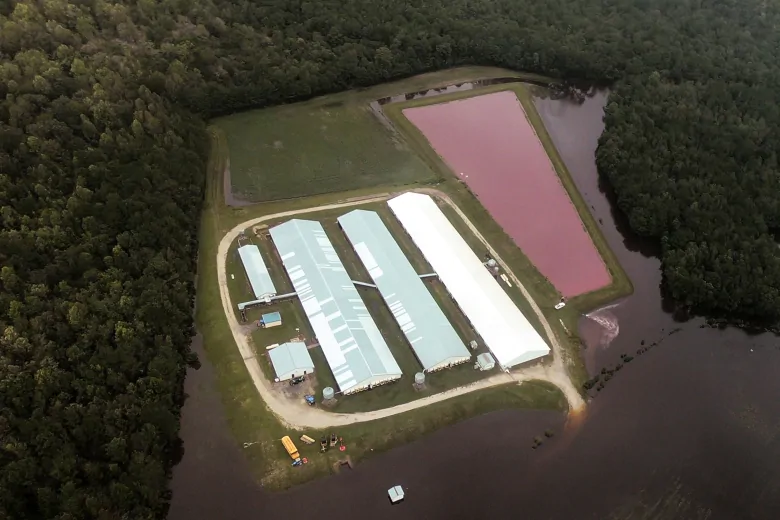Why climate change is increasing the frequency of food-borne illnesses

Climate change is fuelling a rise in people getting sick from food-borne illnesses in Canada and around the world, says a Canadian food safety expert.
The disparate causes include increased flooding that is washing contaminants like salmonella, Listeria and E. coli onto crops, and rising ocean temperatures that allow bacteria to flourish in shellfish.
“As the planet becomes warmer and the air temperature becomes warmer, I expect that we’re going to see more outbreaks,” said Lawrence Goodridge, a professor of food safety at the University of Guelph in Guelph, Ont.
Last year in North Carolina, Hurricane Florence caused widespread flooding. Floodwaters caused lagoons of hog waste at farms to overflow and contaminate crops, said Goodridge. The contaminants in those floodwaters forced the state to ban crops in flooded areas from being used for human consumption.
Destructive weather events like hurricanes can also cause a spike in food-borne illnesses because of the widespread power outages they often create.
“If we can’t refrigerate our food anymore, you know, as the temperature increases in the refrigerator or freezer, the temperature of the food increases and the bacteria grow,” said Goodridge.

But climate change also has more subtle ways of harming our food supply. Over the years, small temperature increases in the ocean have been connected to hundreds of people getting sick in British Columbia, said Eleni Galanis, a physician epidemiologist with the British Columbia Centre for Disease Control.
As the sea warms, it’s easier for vibrio bacteria to grow and accumulate in greater numbers in shellfish like mussels and oysters. That’s led to an increase in the number of British Columbians getting sick after they ate raw or undercooked shellfish.
Vibrio parahaemolyticus, which is the most common form of the bacteria found in B.C. waters, causes diarrhea in humans that can last for up to a week, which can lead to dehydration.

Galanis said in the last three years, stringent restrictions have been put in place in the shellfish industry to curb the number of people getting sick. The industry now tests for vibrio bacteria and monitors water temperatures where the shellfish grow.
If a shellfish has vibrio, it is placed in a freshwater tank and because of how it eats food, the bacteria gets cleaned out of the shellfish, which becomes safe to eat.
If a shellfish company notices the top layers of water where the aquatic animals grow are too warm, they will lower the shellfish into deeper, cooler waters to impede the bacteria’s growth.
“I think that’s a message of hope that we can counter some of the impacts of climate change in our food sources,” said Galanis.

There are lots of hurdles to countering climate change’s effect on food-borne illness though.
Goodridge said some studies indicate the warming weather will lead to an increase in houseflies.
“They fly onto manure, or feces, and then they come and fly onto food, so they can deposit those pathogens on food,” he said.

Despite the concerns about food-borne illnesses increasing because of climate change, there is very little research being done to determine how many people are actually being made sick because of it, said Goodridge.
He said while Canada has some of the best methods for monitoring food safety in the world, there are few systems in place to track how food-borne illness is connected to climate change.
Goodridge said we live in a reactive society, so he fears we’ll only act once a huge outbreak linked to climate change sickens large numbers of people and some people die.
“I think if history tells us anything, that is the wrong approach,” he said.

Goodridge is working to change that. He and others have been researching ways to safely kill bacteria on fruits and vegetables.
He said many bacteria can be destroyed if food is cooked thoroughly, but most fruits and vegetables are consumed raw and washing them won’t necessarily remove harmful bacteria.
Researchers have turned to plants that contain naturally occurring chemicals that kill bacteria. Those chemicals can be extracted and turned into an antimicrobial spray that can be applied to fruits and vegetables.

There are also bacteriophages — naturally occurring viruses that infect and kill bacteria — that are increasingly being used to kill off harmful bacteria. Each phage infects a specific bacteria and will not harm other bacteria, such as healthy gut bacteria that help people digest their food, said Goodridge.
He said roughly one in eight Canadians gets sick each year due to a food-borne illness.
“Even though we have a safe food supply, there’s still much work to be done,” said Goodridge. “As we increasingly see more [extreme] weather events due to climate change, there will be even more work to do.”
MORE TOP STORIES





